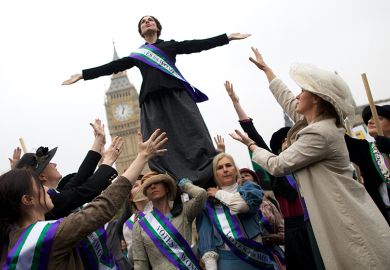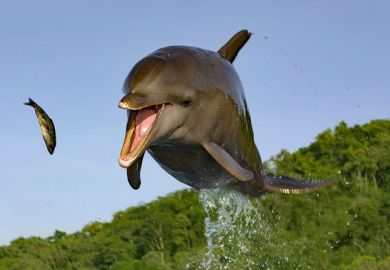An unexpected bonus in Women, Science and Technology , a compilation in "fem-sci studies" for coeds at North Carolina State University, is an article titled "Socially camouflaged technologies: the case of the electromechanical vibrator", by Rachel Maines. It is very informative for ignoramuses who do not know their massager from their dildo. A figure in a Sears Roebuck catalogue from 1918 pictured 15 "aids that every woman appreciates", from electric radiators (various), household mixers with beater and grinder attachments (also buffer and grinder) and a home motor to operate a sewing machine, to vibrator attachments ($1.35) and also a portable vibrator: "neat, compact, with 3 applicators as shown, very useful and satisfactory for home serviceI $5.95". Illegal technology, marketed with circumlocution, included liquor stills, described as "ideal for drinking purposes, and automobile batteries", and also "cycle restorers", or emmenagogues, which were abortifacients.
As to the socioeconomics, the appliances were not reported in the electrical trade press nor by Scientific American . The advertisements appeared in magazines with a median price of 10-20 cents, because readers of 5-cent magazines would not have electricity, while readers of magazines such as Vanity Fair , costing upwards of 25 cents, "were more likely to respond to advertising for spas and private manual massage". Nowadays, it seems, "social camouflage is no longer necessary" (really?).
Women, Science and Technology is good value for money, with five editors and 25 authors, including the usual savantes - Evelyn Fox Keller, Hilary Rose, Harriet Zuckerman, Ruth Hubbard, Ruth Bleier, Judy Wajcman, Helen Longino and now Christine Wenneras and Agnes Wold with their famous expose of "Nepotism and sexism in peer review" by use of the Swedish Freedom of the Press Act. Alison Adam discusses feminist artificial intelligence projects and cyberfutures. Cynthia Daniels describes the sexual politics of foetal hazards such as "crack babies". As with childcare and dishwashing, fathers are beginning to share responsibility for reproductive risks.
Feminist Science Studies: A New Generation is a more revolutionary anthology. Its goal is to reform the science curriculum through "women in science" and "feminism and science" approaches. The editors are a sociologist, a plant evolutionary biologist "exploring her own dislocation as a third-world woman in the sciences in the US", and a cell and molecular biologist, aiming "to integrate the gender, class and race that she saw infiltrating the science she was taught to practice, and to enrich women's studies with science".
These studies, with 37 authors and National Science Foundation support, include resourceful attempts to develop curricula linking questions of gender and feminism with the physical sciences and engineering, creating new inter- and transdisciplinary knowledge, while improving the representation of women and people of colour. Questions of gender dynamics and power differentials are introduced into course material through exercises, role-playing, discussions of human relations in the workplace and guest lectures by female engineers and engineers of colour. Courses are offered that are eligible for credit both in physical science and in women's studies, studying books such as Margaret Wertheim's Pythagoras' Trousers: God, Physics, and the Gender Wars .
The chapter, "Sexy science: what's love got to do with it", by Phoebe Lostroh, describes molecular biology that wins grants and reputations in terms of "master molecules", such as "signal proteins" and other macho metaphors such as "invasion". This is not so much bad science, she says, as master molecule masturbation. "Sexy science" ties in well with the market, which requires new technologies such as gene chips that can be produced and advertised in the sexiest journals (her illustration is Science magazine with a nude woman on the cover). The male-dominated old-boy network includes the biotech business, consultancy and the peer-review process - "as much industry as scholarship".
Sexy science appears again in accounts of female cichlids, tropical freshwater fish, which can be just as colourful, aggressive and competitive as males, and have been described as "male mimics" (!). It also surfaces in accounts of female cuckoos, whose practices of polygyny and egg-dumping extend the meaning of the term "cuckoldry".
Bonnie Spanier provides a useful account of US activism on breast cancer. Breast cancer is the major killer of American women aged 35-44, and the death rate, about a third, is little changed in half a century. Yet the etiology is poorly understood, the field is under-researched and the treatment can be controversial: by radical mastectomy and by powerful drugs such as tamoxifen that are not without side effects. The National Breast Cancer Coalition sent millions of signatures to Congress to seek more funding for access to diagnosis and treatment and to clinical trials. Support and information is offered by women's networks.
The "science shop" is described by Lisa Weasel as a model for feminist science, as it shifts the priorities of academic research towards social issues by offering community access to scientific/technological expertise and problem solving. Science shops were developed in Dutch universities in the 1970s. They have been used in third-world movements opposing (neo) colonial research agendas. In the US, this kind of work was done by the land-grant universities set up in the 19th century, which included many state universities.
Athena Unbound is a patchwork book, with good insights, written over some years by seven US authors, mostly social scientists, and includes their own fieldwork among girls and women at various levels. The book's focus is on academic science, which "serves as a gateway into the larger scientific community".
The international comparisons are particularly good in demonstrating the range of factors in the "women in science" question. Models of femininity vary across cultures, as do the ways in which the different sciences are viewed, the social and financial status of scientists, and the availability of domestic help and childcare.
Female scientists were well supported under communism, but they did not fill many higher positions. Women reach higher levels in science in southern than in northern Europe. A relatively low social status for science, as in Turkey, or a declining academic economy means more women in science. Support from the extended family, as in developing countries, plays a large part in the success of professional women. In a survey of the world's academies of science for the European Commission's European Technology Assessment Network (Etan) report, the Turkish Academy of Science came out top with women comprising 14.6 per cent of its members. Next was Iceland, then Norway, then Finland. The Royal Society's score, which reached 3 per cent in the mid-1960s, is today yet to reach 4 per cent.
In the UK, the barriers to women achieving in science are not much easier to overcome than they were years ago, and it is not clear who the "unbound Athena" is. The expansion of science leads to increases in contract research, which is cruel to many women. When a research contract ends, they find themselves "too old at 50", or even 40, to compete with the rising generation, who are cheaper and more mobile. In fast-moving sciences, training in newer techniques can outweigh longer experience in research. Contract research can be unkind to men also, but they are more mobile than women - usually the family follows - and their children do not interrupt their work.
The authors of Athena Unbound stress the importance of professional networks, instancing the plight of "outsiders" such as Lise Meitner, Barbara McClintock, Maria Goeppert Mayer, Rachel Carson or Rosalind Franklin, and advantages accruing to "insiders" such as Francis Crick and James Watson. Curiously, the book makes no mention of networking self-help for women scientists, perhaps because the authors are not scientists.
Networking can pay off. In the US, the Association for Women in Science (Awis) was founded in 1971 by a group of women that met at summer meetings of experimental biologists. It now has 75 chapters stretching from Alaska to Florida and Hawaii, a substantial presence in Washington, a website (www.awis.org) and an excellent mentoring scheme (www.mentornet.net). Lobbying with allies in Washington has resulted in two acts of Congress: a 1981 act instructing the National Science Foundation to mount affirmative action programmes and a 1998 act creating a Standing Commission on Women and Minorities in Science and Technology.
"Athena unbound" perhaps describes the writing of the book, which has been in gestation for some years (though completed at the gallop, one suspects). Its world tour ends in 1994, just before movement began in Europe. In the UK, the 1993 science white paper, Realising our Potential , described women as "this country's most under-used human resource". A committee was set up to advise the government on "ways in which the potential, skills and expertise of women could best be secured". In 1994, it produced The Rising Tide: A Report on Women in Science, Engineering and Technology , which documented the loss of girls and women from science, engineering and technology at every stage. Its many recommendations included career advice, mentoring, family-friendly measures, help for would-be returners to science and creating a Promoting SET for Women Unit in the Office of Science and Technology.
The Rising Tide recognised the value of networking and mutual support among women in science. The government's response, accepting the proposals (except for tax relief on childcare) "looks forward to the work in this area of the newly formed Association for Women in Science and Engineering", Awise. Remarkably, some Awise branches formed spontaneously after a brief mention of Awise in the New Scientist of March 5 1994 on the launch of The Rising Tide . Awise fills a need for women in science, science teaching, administration and the media (see www.awise.org). A new project, with the Women's Engineering Society, is to develop a national mentoring operation to help women survive in science, engineering and technology. Comparable associations operate in Canada, South Africa, Australia and New Zealand, and following the Etan report, an association is being created in France. There is also one, TWOWS, for women in the third world. Female mathematicians have formed strong national and international links (EWM), and women in information technology are doing so, too.
Edith Cresson set up a Women in Science Unit in the European Commission's research directorate-general in Brussels in the 1990s. This has been flexing its muscles, holding meetings and networking the networks. The unit set up the Etan group of 14 women from 11 European Union countries to produce the 1999 report, Science Policies in the European Union: Promoting Excellence through Mainstreaming Gender Equality . It also formed the Helsinki group of national civil servants who deal with "women in science" questions. A target of 40 per cent female participation is set for the 6th Framework Programme: "aiming high but sometimes falling short", says the action plan. It is a long haul.
Joan Mason is a scientist and chair of the Association for Women in Science and Engineering (Awise).
Feminist Science Studies: A New Generation
Editor - Maralee Mayberry, Banu Subramaniam and Lisa Weasel
ISBN - 0 415 92695 5 and 92696 3
Publisher - Routledge
Price - £50.00 and £15.99
Pages - 341
Register to continue
Why register?
- Registration is free and only takes a moment
- Once registered, you can read 3 articles a month
- Sign up for our newsletter
Subscribe
Or subscribe for unlimited access to:
- Unlimited access to news, views, insights & reviews
- Digital editions
- Digital access to THE’s university and college rankings analysis
Already registered or a current subscriber?



